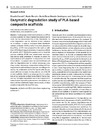Identificador persistente para citar o vincular este elemento:
https://accedacris.ulpgc.es/jspui/handle/10553/72766
| Título: | Enzymatic degradation study of PLA-based composite scaffolds | Autores/as: | Donate, Ricardo Monzón, Mario Alemán-Domínguez, María Elena Ortega, Zaida |
Clasificación UNESCO: | 3312 Tecnología de materiales 3313 Tecnología e ingeniería mecánicas 3314 Tecnología médica |
Palabras clave: | Polylactic acid PLA bone tissue engineering Bone tissue engineering Proteinase K |
Fecha de publicación: | 2020 | Proyectos: | Mejora de la Biofuncionalidad de Scaffolds Polimericos Obtenidos Por Fabricacion Aditiva | Publicación seriada: | Reviews on Advanced Materials Science | Resumen: | Disadvantages in the use of polylactic acid (PLA) as a base material for Tissue Engineering applications include the low osteoconductivity of this biomaterial, its acidic degradation and the deficient cellular adhesion on its surface. In order to counteract these drawbacks, calcium carbonate (CaCO3) and β-tricalcium phosphate (Ca3(PO4)2, β-TCP) were proposed in this work as additives of PLA-based support structures. Composite scaffolds (PLA:CaCO3:β-TCP 95:2.5:2.5) manufactured by fused deposition modeling (FDM) were tested under enzymatic degradation using proteinase K enzymes to assess the modification of their properties in comparison with neat PLA scaffolds. The samples were characterized before and after the degradation test by optical microscopy, scanning electron microscopy, compression testing and thermogravimetric and calorimetric analysis. According to the results, the combination of the PLA matrix with the proposed additives increases the degradation rate of the 3D printed scaffolds, which is an advantage for the application of the composite scaffold in the field of Tissue Engineering. The higher degradation rate of the composite scaffolds could be explained by the release of the additive particles and the statistically higher microporosity of these samples compared to the neat PLA ones. | URI: | https://accedacris.ulpgc.es/handle/10553/72766 | ISSN: | 1605-8127 | DOI: | 10.1515/rams-2020-0005 | Fuente: | Reviews on Advanced Materials Science [ISSN 1605-8127], v.59 (1), p. 170-175 |
| Colección: | Artículos |
Citas SCOPUSTM
40
actualizado el 08-jun-2025
Citas de WEB OF SCIENCETM
Citations
38
actualizado el 08-jun-2025
Visitas
129
actualizado el 27-ene-2024
Descargas
95
actualizado el 27-ene-2024
Google ScholarTM
Verifica
Altmetric
Comparte
Exporta metadatos
Los elementos en ULPGC accedaCRIS están protegidos por derechos de autor con todos los derechos reservados, a menos que se indique lo contrario.
